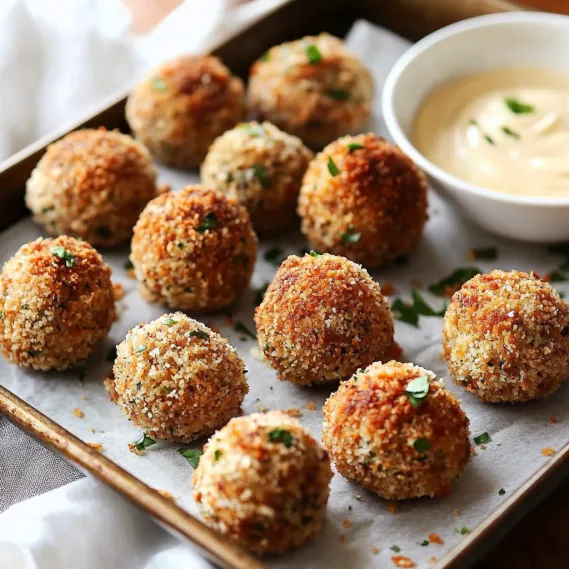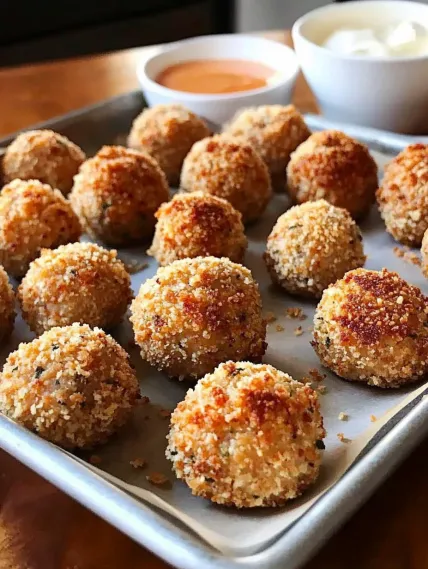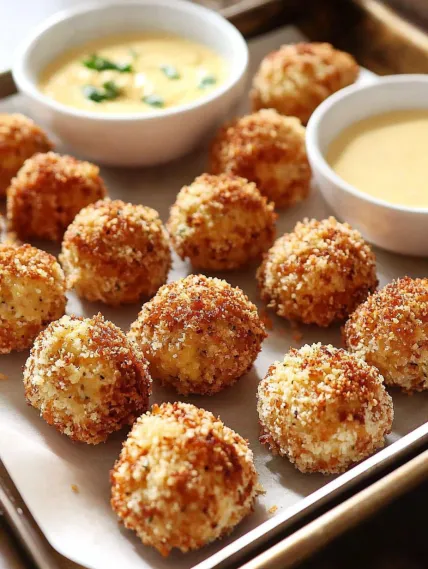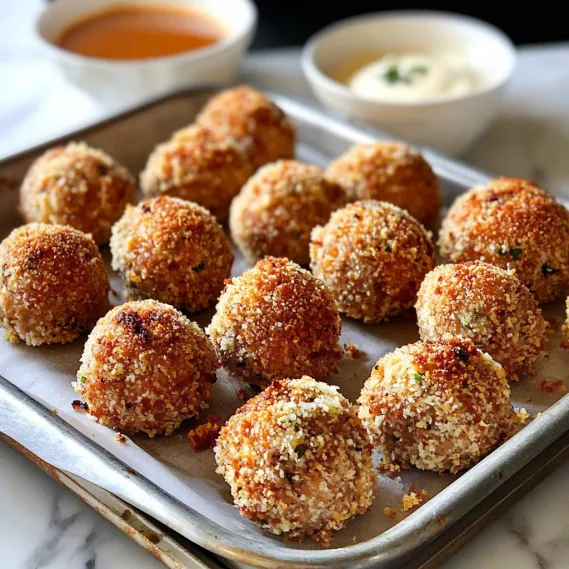 Pin
Pin
Baked Boudin Balls transform a beloved Cajun staple into a healthier yet equally satisfying appetizer that celebrates the rich culinary traditions of South Louisiana. These golden, crispy orbs deliver all the complex flavors of traditional boudin—the perfect balance of savory pork, aromatic rice, and Cajun seasonings—without the heavy oil of deep frying. I've served these at countless gatherings, and they never fail to disappear within minutes, often before other appetizers are even touched.
My first introduction to boudin balls came at a family reunion in Lafayette, where my cousin's grandmother insisted I try her "healthier version" that she baked instead of fried. I was skeptical until that first bite—crispy, savory, and bursting with flavor that transported me straight to the bayou. She shared her secret technique of freezing the balls before breading, which I've incorporated into this recipe.
Essential Ingredients and Selection Tips
- Boudin Sausage: Look for fresh (not smoked) boudin from a reputable butcher or Cajun specialty shop. The best boudin has a balanced meat-to-rice ratio with noticeable specks of green onion and parsley.
- Panko Breadcrumbs: These Japanese-style breadcrumbs create a significantly crispier coating than traditional breadcrumbs, even when baked.
- Cajun Seasoning: For the dipping sauce, use an authentic Cajun seasoning blend such as Tony Chachere's or Slap Ya Mama.
- Eggs: Act as both a binder in the boudin mixture and part of the breading process. Farm-fresh eggs provide the best flavor and richness.
- Cooking Spray: A light coating helps achieve that golden, crispy exterior. Choose an olive oil or avocado oil spray for better flavor.
I've found that the texture of your boudin makes a big difference in the final result. If your boudin seems particularly moist or loose, add a tablespoon of plain breadcrumbs to the mixture to help it hold shape better during the forming and freezing process.
Detailed Cooking Instructions
- Step 1: Prepare With Precision
- Line two baking sheets with parchment paper—one for freezing the shaped balls and another for baking. Preheat your oven to 425°F, making sure it reaches full temperature before baking.
- Step 2: Master the Mixture
- Remove the casing from 1 pound of boudin sausage by slicing lengthwise and peeling away the casing. Break the filling into a large bowl, breaking it up with your fingers to ensure even distribution. Add 2 lightly beaten eggs and mix gently but thoroughly until well combined.
- Step 3: Shape With Skill
- Using a tablespoon or cookie scoop, portion out the mixture and roll between your palms to form uniform balls. Place them on your parchment-lined baking sheet, leaving space between each. Lightly moisten your hands with water to prevent sticking during rolling.
- Step 4: Freeze For Success
- Place the baking sheet with the formed balls in the freezer for at least 30 minutes until firm to the touch. This helps maintain their shape during the breading process and creates better texture contrast.
- Step 5: Bread With Technique
- Set up a breading station with flour, beaten eggs mixed with milk, and panko breadcrumbs. Working with a few balls at a time, roll each in flour, dip in egg mixture, then coat in panko, pressing gently to adhere. Transfer to the second baking sheet.
- Step 6: Bake to Perfection
- Bake at 425°F for 25-30 minutes until golden and crispy on the outside, turning halfway through baking. Cool briefly on the baking sheet before serving.

My first attempt at these boudin balls taught me the importance of proper freezing time. I tried to rush the process for unexpected guests. Without proper freezing, the balls flattened during baking and lost their appealing round shape. My grandmother always said, "Good Cajun cooking can't be rushed," and this is definitely true for boudin balls!
Louisiana's Culinary Heritage
These boudin balls represent more than just a tasty appetizer—they're a connection to the rich culinary traditions of Louisiana. Boudin itself evolved from French charcuterie techniques adapted to local ingredients by Cajun settlers. The original boudin was made from pork, rice, and seasonings as a way to utilize every part of the animal during butchering season. By transforming this humble sausage into crispy, golden appetizers, we're keeping tradition alive while making it accessible to modern palates and dietary preferences.

Perfect Pairing Possibilities
The versatility of these boudin balls extends to their pairing potential. For casual gatherings, I serve them alongside ice-cold Abita beer or a crisp lager that cuts through the richness. For more upscale occasions, they pair surprisingly well with champagne, creating an unexpected high-low culinary experience that delights guests. During football season, these make regular appearances at our house alongside gumbo and jambalaya, creating a Louisiana-themed spread that satisfies even the hungriest fans.
Make-Ahead Magic For Entertaining
One of the greatest advantages of this recipe is its make-ahead flexibility. I often prepare these in stages when hosting: shape and freeze the balls up to a month in advance, bread them the day before (storing them covered in the refrigerator), and then simply bake them before guests arrive. The aroma of these baking fills the house with an irresistible scent that sets the tone for a delicious gathering. For larger parties, I make double batches, keeping the second batch warm in a low oven until needed.
Transforming Leftovers Into New Meals
If you somehow end up with leftover boudin balls (though this rarely happens in my house!), they can be transformed into entirely new dishes. Crumble them into scrambled eggs for a Cajun-inspired breakfast hash, or slice them and add to a simple green salad with a spicy vinaigrette for a light lunch. My favorite repurposing trick is to nestle halved leftover boudin balls atop a bowl of creamy grits, creating a satisfying breakfast that carries the flavors into the next day.

Chef's Helpful Tips
- Allow the balls to rest for 5 minutes after baking before serving – this helps set the interior for the perfect bite
- For extra flavor dimension, add a teaspoon of smoked paprika to your panko mixture
- If you have trouble finding boudin locally, order it online from authentic Louisiana suppliers like Bourgeois Meat Market or The Best Stop
- Serve with multiple dipping options – a spicy remoulade and cool ranch alongside the Louisiana dipping sauce
- For a festive Mardi Gras presentation, arrange the balls on a platter with alternating sprinkles of chopped parsley, purple cabbage, and yellow bell pepper to represent the traditional green, purple, and gold
Recipe FAQs
- → What is boudin and where can I find it?
- Boudin is a Cajun sausage made with pork, rice, and seasonings found at specialty meat markets or well-stocked supermarkets.
- → Can I make these ahead of time?
- Yes, prepare through breading step and freeze uncooked for up to a month, then bake directly from frozen.
- → Can I use an air fryer instead of baking?
- Yes, air fry at 380°F for 12-15 minutes, shaking halfway through for a crispier exterior.
- → What can I substitute for boudin if I can't find it?
- Make a similar mixture using cooked rice, ground pork, bell peppers, onions, and Cajun seasoning.
- → What other dipping sauces work well with boudin balls?
- Remoulade sauce, Cajun mustard, mayonnaise with hot sauce, or honey all pair well with boudin balls.
